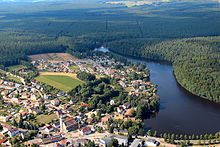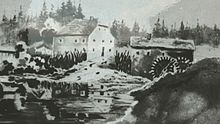Bodenwohr Castle
The Outbound Castle Bodenwoehr was in the same community Bodenwöhr in the district of Schwandorf the administrative district of the Upper Palatinate . Underground findings of the broken early modern hammer lock of Bodenwöhr are still available and are listed in the monument list for Bodenwöhr as listed objects (D-3-6739-0124).
history
The area around Bodenwöhr (first mentioned as Potenwre in 1123 ) came at the beginning of the 12th century as a gift to the Ensdorf monastery .
Weichselbrunn hammer
About one kilometer northwest of the "Potenwur" mill, the Weichselbrunn hammer was built a century later. This was called Weichselbrunner Hammer because of its location on the corresponding pond. According to a statement by Johann Georg Lori from 1764, it is alleged that this hammer had existed "since prehistoric times" as the sovereign property. The Ensdorf monastery still owned land there; this emerges from a compensation payment in 1470 because of a drowned "Wiesmahd". The hammer mill is said to have existed as early as 1292 and after the hammer was moved to Bodenwöhr, the large iron slag heaps were "consumed" for a long time. There is no documentary evidence of its establishment, so this secondary source must be used.
The hammer masters did not live in the hammer hut, but in a house a few hundred meters to the east on a hill, the so-called castle, from which the castle hill of Bodenwöhr derives its name. After the end of the Weichselbrunn hammer, the building lost its importance and fell into disrepair. In the middle of the 18th century "rudera" (heaps of rubble or rubble) could still be found in the forest. Remnants of the Hammermeister's house are said to have been used in the 19th century for the construction of houses. When the Hammerweiher was let down in 1950, remains of the old hammer mill came to light. The village of Hottersdorf (or Hadersdorf), between Bodenwöhr and Blechhammer, which had to be paid to the parish of Bruck , also belonged to the hammer . This place is said to have come to an end when the Bodenwoehrer Hammersee was dammed or during the Thirty Years' War .
The last owner of the Weichselbrunn hammer was Gilg Kotz, who owned it on a long lease until around 1464 . The Landschreiber zu Neunburg vorm Wald , Hans Vogel, also had partial rights to this hammer, as his father Christoph Vogel owned the hammer in whole or in part. This emerges from a lawsuit against Gilg Kotz for outstanding interest payments. The hammer must have been deserted long before 1464, perhaps because of a fire or the Hussite Wars .
Hammer Bodenwöhr
In 1464, the hammer was probably moved to Bodenwöhr for water management reasons. At the new location, the waters from the Weichselbrunner and Warbrucker Weiher meet and so more water was available to operate the hammer. Gilg Kotz probably began construction in 1463, but he died that year and his son Hans Kotz followed him. With a certificate dated March 5, 1464, Count Palatine Otto I of Pfalz-Mosbach-Neumarkt granted him the right of inheritance to the Hammer Bodenwöhr. After the Hans Kotz, the Amberg hammer masters Dietz Sailer the old and Hanns Sailer the young followed. According to the Salbuch of the Neunburg district court of 1499, Ulrich Streun (also written in Strewen, probably belonging to the Ströbel family of hammer masters) was the hammer master who had to pay 20 guilders in interest every year. The next hammer owner was Hans Heber († 1518). His widow and son Veit Heber and his siblings demanded compensation for the broken pond “am Barnmoss” in the Brucker Forest, which was granted in 1520 when the community of Bruck gave the rebuilt pond to Elector Ludwig II of the Palatinate and his brother Friedrich II . sold.
In 1538 the hammer Bodenwöhr delivered 40 pounds of Radeisen for 740 guilders to Regensburg. The iron ore extracted from Hinter- and Vorderthürn near Bruck was smelted there. In the description of the Bruck office from 1550 it says: “In benenten pach (meaning Sulzbach) ligt first ain hamer, called belonging to the pettenwuer in Neuburger rulers.” In the 17th century it was a hammer .
After the Sailers, the hammer was owned by the Sonnleutner families. In 1537 the hammer master Hanns Sonnleithner zu Schwandt was buried, in 1550 Lienhard Sonnleutner was named hammer master zu Pottenwier. In 1564 Georg Sonnleutner sold the hammer to Geog Drösch and Hanns Keßporer, citizens of Regensburg. In 1565 they leased it to the controversial Bartholomäus Spatz († 1590), in 1573 the hammer and the mill were sold to Bartholomäus Spatz for 6000 Rhenish guilders . In 1587 his son Hans Spatz took over the property. After his death, his widow married the hammer master Paulus Hartung. Around 1681 Wilhelm Seitz, Hans Spatz's son-in-law, bought the hammer for 13,000 guilders. Seitz was shot in 1632 by the dragoons of the Aldringen regiment when they raided Markt Bruck; he died of the gunshot wound. His wife Dorothea had died in 1631. The Hammergut was no longer inhabited and came to the Gant .
On October 2, 1670, Johann Schreyer, who came from an old Upper Palatinate hammer family, bought the barren Hammer Bodenwöhr, located under Gant, for 50 guilders. By 1672 Schreyer succeeded in rebuilding the hammer with the Weiherdamm and Weihergraben. In 1677 the newly built hammer mill burned down together with the full coal bed. Schreyer rebuilt it immediately. In 1680 the Schreyer family was ennobled . Jakob Schreyer, the brother of Johann Schreyer, was raised to the nobility by Emperor Leopold I on October 23, 1680 and his four brothers were also given permission to name themselves after their possessions. Schreyer suffered further hardships with the hammer: In 1682 the ponds were ruined "by wild water" and the hammer hut burned down in the same year. But Schreyer immediately went back to repairing the damage. He was actively supported by the forest master of Taxöldern , Bartholomäus Sechser, who stood up for him in the government.
On May 4, 1693, the General Building Department of Bavaria acquired the iron hammer and built a smelting furnace. The purchase price was 10,000 guilders and 33 guilders on loan. The Schreyer family struggled to get this money from the state. Schreyer, who died on February 26, 1709, did not see full payment any more (the dispute lasted until 1795). The General Building Directorate was founded in 1688 and was responsible for the entire forestry and mining sector in Bavaria. The ironworks was one of the most important in Germany. Candelabra, bridge railings, coats of arms, reliefs and the like were made there in the cold casting process. a. m. as well as enamelled cast bathtubs and oil stoves. The Bodenwöhr iron and steel works were closed as a state enterprise in 1971; then prefabricated houses were built on the site by a Regensburg construction company. The Hammersee , which today mainly serves tourist purposes, still bears witness to the former hammer mill .
The official building or the castle of Bodenwöhr
The hammer master Hans Kotz had a new house built. This was still mentioned in the description of the desolate hammer property in 1667, but was dilapidated ("completely ruined and perished in the tachung"). When the hammer mill was rebuilt in 1671 by Johannes Schreyer, the hammer man's house was rebuilt on the foundation walls of the previous building. When the Bavarian state acquired the Hammergut, the building was designated as an official residence and enlarged by adding a law firm (around 1693). At that time the building still had a small clock tower with a bell. In 1900, a new mining and smelter office building was built opposite the official palace and the offices were relocated there. The miner kept his apartment in the old castle until 1913, after which it was also moved to the new official building. From 1923 to 1928 a larger room was used as a prayer room for the Evangelical Lutheran parish. After the Second World War , the building was used for residential purposes and then used again by the iron and steel works for offices.
coat of arms
The Bodenwöhr coat of arms with a diagonally crossed golden mallet and a golden iron indicates the ironworks that were built in the 15th century.
literature
- Wilhelm Blab: Bodenwoehr; History and cultural development of a Bavarian mountain and hut town . Verlag Bodenwöhr Municipality, Bodenwöhr, 1960.
- Ingrid Schmitz-Pesch: Roding. The care offices Wetterfeld and Bruck (= Historical Atlas of Bavaria, part of Altbayern Heft 44). Commission for Bavarian History, Verlag Michael Lassleben, Munich 1986, ISBN 3-7696-9907-6 .
Web links
Individual evidence
- ↑ Bodenwöhr list of monuments
- ^ Wilhelm Blab, 1960, p. 15 ff.
- ↑ Duden online
- ↑ Ingrid Schmitz-Pesch, 1986, p. 404.
- ^ Franz Michael Ress (1950). History and economic importance of the Upper Palatinate iron industry from the beginning up to the time of the 30-year war. Regensburg: Publishing house of the historical association of Upper Palatinate and Regensburg.
- ↑ Maximilian Prokop von Freyberg: Pragmatic History of Bavarian Legislation and State Administration since the Times of Maximilian I. At Friedrich Fleischer in Comm., Leipzig: 1836, p. 197.
- ^ Wilhelm Blab, 1960, p. 616.
Coordinates: 49 ° 16 ′ 19 ″ N , 12 ° 18 ′ 27 ″ E





